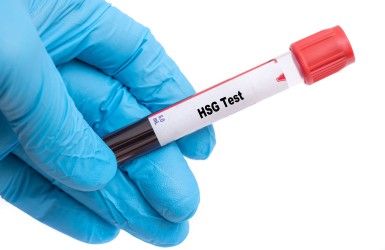Women's Wellness
Struggling with Irregular Periods or Fertility Issues? An HSG Test Can Help
5 min read
By Apollo 24|7, Published on - 29 May 2025
Share this article
0
0 like

If you're experiencing irregular menstrual cycles or struggling to conceive, it can be a deeply emotional and confusing time. However, advanced medical science offers several tools to help diagnose potential causes of infertility. One such informative and commonly recommended procedure for women facing these challenges is the HSG test, or hysterosalpingogram.
This diagnostic imaging procedure plays a pivotal role in assessing female reproductive health, particularly when it comes to identifying issues with the fallopian tubes (the tubes connecting the ovaries to the uterus). In this article, we will explore what the HSG test involves, why it’s important, who should consider it, and how it can potentially aid fertility.
What Is an HSG Test?
The HSG test (hysterosalpingogram) is a specialised X-ray examination used to evaluate the shape of the uterus and the condition of the fallopian tubes. It involves injecting a contrast dye into the uterus through the cervix. As the dye travels through the reproductive tract, X-ray images are captured to observe its flow.
A normal test shows the dye flowing freely through the uterus and both fallopian tubes, indicating that they are open. If the dye does not pass through the tubes, it may indicate a blockage, which is one of the leading causes of infertility in women.
How Does the HSG Test Help in Fertility Issues?
When couples face difficulties in conceiving, blocked fallopian tubes are often a hidden culprit. The fallopian tubes play a critical role in the reproductive process by allowing the sperm to meet the egg and facilitating the fertilised egg's journey to the uterus.
The HSG test can detect:
- Tubal Blockages: Obstructions that prevent sperm from reaching the egg.
- Uterine Abnormalities: Structural anomalies like fibroids, polyps, or adhesions that can affect implantation of the foetus on the walls of the uterus.
- Scarring from Infections or Surgeries: Especially in women with a history of pelvic inflammatory disease or previous pelvic operations.
- Congenital Uterine Conditions: Variations in uterine structure that may cause repeated miscarriages or difficulties conceiving.
By identifying these issues early, the HSG test allows for timely intervention, enhancing the chances of a successful pregnancy.
Who Should Consider the HSG Test?
Your healthcare provider may recommend an HSG test if you have:
- Been trying to conceive for over 12 months (or 6 months if you’re over 35).
- Irregular or absent menstrual periods.
- A history of multiple miscarriages.
- Pelvic infections, such as pelvic inflammatory disease (PID).
- Undergone surgery involving the uterus or fallopian tubes.
- Had an ectopic pregnancy in the past.
- Symptoms such as chronic pelvic pain or unusual vaginal discharge.
In such cases, the HSG test becomes a critical part of the diagnostic process for unexplained infertility.
How to Prepare for an HSG Test?
Preparing correctly for an HSG test ensures both safety and effectiveness. Here’s what you need to know:
1. Timing
The test is usually performed between days 6 and 12 of your menstrual cycle, shortly after your period ends but before ovulation. This timing helps ensure that you’re not pregnant during the procedure.
2. Abstinence
Avoid sexual intercourse from the end of your period until after the test to eliminate the risk of pregnancy.
3. Medications
You may be advised to take a mild painkiller, such as ibuprofen, 30 to 60 minutes before the procedure to minimise cramping. If you’re allergic to iodine or contrast dye, inform your doctor in advance.
4. Infections
If there is any indication of infection, such as a recent bout of PID, the HSG test may be postponed. Your doctor might prescribe antibiotics before or after the test to reduce the risk of infection.
Have more questions?
What Happens During the HSG Test?
The procedure typically lasts about 15 to 30 minutes and is performed in a radiology or gynaecology department. Here’s what to expect:
- Positioning: You’ll lie on your back with your knees bent and feet placed in stirrups, similar to a Pap smear.
- Speculum Insertion: A speculum is inserted into your vagina to visualise the cervix.
- Catheter Placement: A thin tube (catheter) is gently inserted into the cervix. Through this, the contrast dye is introduced into the uterus.
- Dye Injection and Imaging: The dye fills the uterine cavity and travels through the fallopian tubes. As this happens, a series of X-ray images (fluoroscopy) is taken to observe the dye’s path.
- Completion: After the imaging is complete, the catheter and speculum are removed, and you’ll be monitored briefly before being allowed to go home.
Some women experience mild to moderate cramping during the test, especially if a fallopian tube is blocked. However, the discomfort usually subsides shortly after the procedure.
Understanding Your HSG Test Results
The radiologist or gynaecologist will interpret the images and provide a detailed report.
Normal Results
- Dye flows freely through the uterus and both fallopian tubes.
- The uterine cavity appears regular in shape.
- Indicates no major structural or tubal issues.
Abnormal Results
- Dye is unable to pass through one or both tubes, suggesting a blockage.
- Irregular uterine shape due to fibroids, adhesions, or congenital malformations.
- Scarring or inflammation may also be detected.
Depending on the findings, your doctor will discuss the next steps, which could include further tests, surgery, or assisted reproductive techniques like IVF.
Are There Any Risks or Side Effects?
The HSG test is generally considered safe, but like all medical procedures, it carries some risks:
- Cramping and Discomfort: Mild to moderate during and shortly after the test.
- Vaginal Spotting: Light bleeding for a day or two post-procedure.
- Allergic Reaction: Rare, but possible due to iodine-based contrast dye.
- Infection: Pelvic infection can occur, particularly in those with a history of PID.
- Uterine Perforation: Extremely rare, but a theoretical risk if instruments accidentally puncture the uterine wall.
Seek medical attention if you experience severe pain, fever, heavy bleeding, or foul-smelling vaginal discharge after the test.
Conclusion
The HSG test is a valuable, minimally invasive diagnostic tool that can provide essential insights into the causes of infertility or irregular periods. By examining the structure of the uterus and the patency of the fallopian tubes, this test helps identify potential barriers to conception and opens the door to more effective treatments.
If you’ve been trying to conceive without success or you’re dealing with unexplained menstrual irregularities, consult your healthcare provider about whether the HSG test is right for you. Timely diagnosis is often the first and most important step towards a successful pregnancy journey.
Book HSG Test
Frequently Asked Questions
Is the HSG test painful?
Is the HSG test painful?
How soon can I try to conceive after an HSG test?
How soon can I try to conceive after an HSG test?
Can the HSG test detect all causes of infertility?
Can the HSG test detect all causes of infertility?
What Happens After the HSG Test?
What Happens After the HSG Test?
Can the HSG Test Improve Fertility?
Can the HSG Test Improve Fertility?
Leave Comment
Recommended for you

Women's Wellness
Eating Right During and after Pregnancy for Maintaining a Healthy Weight
Weight gain during pregnancy allows the baby to grow to a healthy size, but gaining too much or too little weight may create an issue for the baby.

Women's Wellness
Why Some Women Experience Heartburn During Pregnancy
Changes in hormone levels and body shape due to the baby growing may be the cause of heartburn in pregnant women. Usually, heartburn symptoms are mild and manageable during pregnancy.

Women's Wellness
Do All Women Need Folic Acid Supplements?
Folate is required by the body for the formation of RBCs and WBCs in the bone marrow. It is also important for proper growth and development during pregnancy and infancy.
Subscribe
Sign up for our free Health Library Daily Newsletter
Get doctor-approved health tips, news, and more.
Recommended for you

Women's Wellness
Eating Right During and after Pregnancy for Maintaining a Healthy Weight
Weight gain during pregnancy allows the baby to grow to a healthy size, but gaining too much or too little weight may create an issue for the baby.

Women's Wellness
Why Some Women Experience Heartburn During Pregnancy
Changes in hormone levels and body shape due to the baby growing may be the cause of heartburn in pregnant women. Usually, heartburn symptoms are mild and manageable during pregnancy.

Women's Wellness
Do All Women Need Folic Acid Supplements?
Folate is required by the body for the formation of RBCs and WBCs in the bone marrow. It is also important for proper growth and development during pregnancy and infancy.